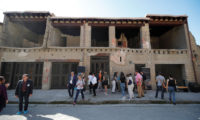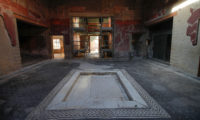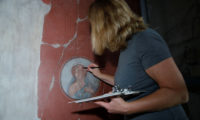 One of Herculaneum’s greatest architectural and artistic gems has reopened to the public in grand style 36 years after it was closed in dismal condition.
One of Herculaneum’s greatest architectural and artistic gems has reopened to the public in grand style 36 years after it was closed in dismal condition.
Bicentenary House was home to Gaius Petronius Stephanus and his wife Calantonia Themis. It was one of the city’s finest private houses, with well-preserved mosaic floors and frescoes depicting mythological scenes and architectural and animal motifs.
The house gave onto Herculaneum’s main street and the entrance had a sliding wooden grill, which survived the volcanic inferno. “It is 2,000 years old. It is one-of-a-kind with its delicate decorations,” said Domenico Camardo, chief archaeologist at the Herculaneum Conservation Project.
 Three stories high and 6,500 square feet in area, the House of the Bicentenary is considered Herculaneum’s most sumptuous noble villa (most of the ancient city remains buried under 60 feet of volcanic rock and the modern city on top of that). Its tablinium (reception room) is particularly splendid, with frescoes of the highest quality depicting scenes from mythology on the walls and an exceptional mosaic floor that combines opus sectile (prized stone materials like colored marbles custom cut and inlaid) and opus tessellatum (cube tiles at least 4mm long and wide).
Three stories high and 6,500 square feet in area, the House of the Bicentenary is considered Herculaneum’s most sumptuous noble villa (most of the ancient city remains buried under 60 feet of volcanic rock and the modern city on top of that). Its tablinium (reception room) is particularly splendid, with frescoes of the highest quality depicting scenes from mythology on the walls and an exceptional mosaic floor that combines opus sectile (prized stone materials like colored marbles custom cut and inlaid) and opus tessellatum (cube tiles at least 4mm long and wide).
The domus got its modern name because it was discovered in 1938, the bicentenary of the beginning of excavations at Herculaneum in 1738. Led by archaeologist Amedeo Maiuri, the open-air excavations during this period took place side-by-side with stabilization, restoration and exhibition of the sites. Artifacts found inside the domus were exhibited in the hall to the left of the atrium, which had been stabilized by crews of on-site masons and carpenters, as excavation continued in the rest of the villa. In the hall to the right of the atrium a sliding wood screen with a carved lintel, preserved by the eruption, was conserved and then displayed in situ for visitors. The tablinium frescoes and pavement were restored and that space was also opened to the public.
By 1983, the House of the Bicentenary was in dire straits from its exposure to the elements and its popularity with tourists. It was structurally unsound and the wall paintings were deteriorating at an alarming rate. The tuffa wall was breaking apart, the plaster layers separating off the walls, the paint layers flaking and turning to dust. Biological organisms, pollution particles, dirt and a coating from a previous restoration that was supposed to help preserve it but has instead accelerated the flaking were degrading the integrity and colors of the paint. The mosaic was lifting off the floor and had suffered significant tile loss.
 In 2011, the Getty Conservation Institute (GCI) embarked on a comprehensive new conservation project of the House of the Bicentenary in collaboration with the Archaeological Park of Herculaneum and the Herculaneum Conservation Project. The team focused on the tablinium, starting with extensive research, study and documentation of the site’s condition and using that data to tailor a conservation plan that would stabilize and treat the wall paintings, mosaic pavement and architectural surfaces.
In 2011, the Getty Conservation Institute (GCI) embarked on a comprehensive new conservation project of the House of the Bicentenary in collaboration with the Archaeological Park of Herculaneum and the Herculaneum Conservation Project. The team focused on the tablinium, starting with extensive research, study and documentation of the site’s condition and using that data to tailor a conservation plan that would stabilize and treat the wall paintings, mosaic pavement and architectural surfaces.
For example, researchers were able to identify the materials and methods used by the ancient artists to create the frescoes and each those used in later restorations. This was a complex multi-layers problem that required thorough archival research of Maiuri’s photographs and written records, close visual examination, imaging technology, scientific tests in situ and in the laboratory. Environmental monitoring of different parts of the room and analysis of the salts and biogrowths revealed how temperature, water and salt in the air and ground contributed to organism growth and the damage to the plaster and paint.
The project has been so successful in stabilizing the grand domus that not only can the site itself be reopened to the public, but the passive environmental approaches, materials and technologies used by the conservation team will now be deployed on other structures in the ancient city.
“It was an occasion to develop new, innovative materials and methods for conservation that can be used in the site and elsewhere,” said Rainer, explaining that other frescoes at the site had been covered by the same, damaging coating [that caused flaking in the triclinium wall paintings].
Indeed, the wealth of information from the conservation project and ongoing monitoring of conditions at the House of the Bicentenary will be of invaluable aid to the other sites struck by Vesuvius in 79 A.D. that are experiencing the same kinds of deterioration issues.